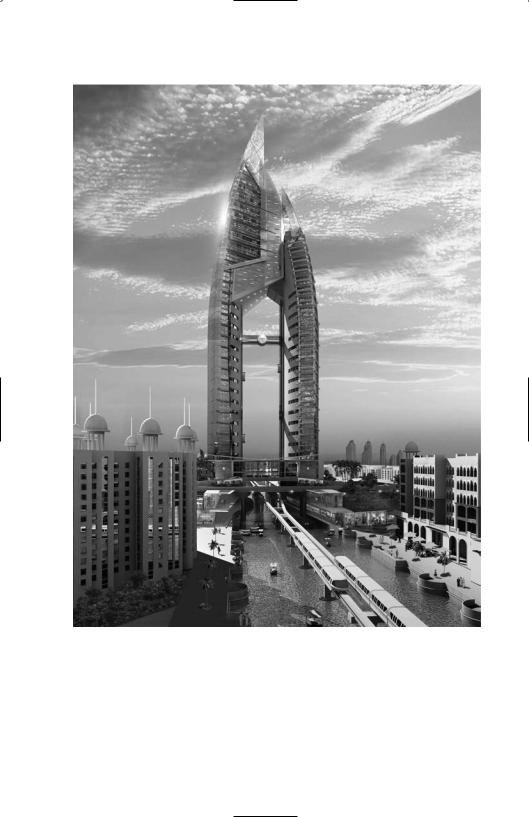
Trump_Never_Give_Up
.pdf
T R U M P : N E V E R G I V E U P
the signature on my letter for enough money to cover the charitable donation he was enclosing. I wrote back thanking him and told him I like having shrewd friends who k now a good business deal when they see one. Both of us had a good laugh, and a good cause benefited.
That’s one way business works, and it can make every day a pleasure. Try to spice up your dealings and daily work routine with occasional jokes and laughter, and you’ll see how much more enjoyable your work will become. The people you work with will appreciate it, too, if you can make them laugh.
After the first season of The Apprentice, I wrote Mark Burnett a letter about how it had been a fantastic experience working with him. I explained to him that little did I k now while writing The Art of the Deal back in 1987 that it would become a bestseller while at the same time being a catalyst to a young man selling T-shirts on Venice Beach in California. (That young man was Mark Burnett.) I also told him that if I’d ever said anything negative about guys who hang out on the beach, that “I hereby take it back.” We had become business partners but also friends, and the humor we enjoyed made the experience all the better.
It pays to have a sense of humor about yourself. I did a commercial for V ISA a few years ago that required me to grovel around (or appear to be groveling around) in a dumpster to retrieve my V ISA card. I was filmed on top of Trump Tower showing my card, when a gust of wind blows it out of my hand and onto the street below. A passerby notes when I crawl out of the dumpster, “And I thought he was doing so well!” I didn’t mind—I had a great time and the commercial was a big success. If I took myself too seriously, I would have missed out on a lot of fun and a nice paycheck. Business at its best should have both.
90

21
S O M E T I M E S Y O U H A V E
T O S T A R T O V E R
D u b a i
Sometimes it’s in your best interest to start over, even if you’re established and can afford to do as you please. A good
example of that is the new Palm Trump International Hotel & Tower that’s going up in Dubai. I think most of us have heard of Dubai by now, in the United Arab Emirates. Just off the coast is
aman-made palm-tree-shaped island, the Palm Jumeirah, that is
aremarkable achievement of engineering and imagination. I partnered with Nakheel, the developer of over $30 billion in real estate in Dubai, to build a tower on this island.
Nakheel, in Arabic, means palm trees, so it follows that this would be their imprint in the Arabian Gulf. In 2005, we went into partnership and agreed that our hotel, which will be the
91

T R U M P : N E V E R G I V E U P
luxury pivot point of the Palm Jumeirah, should be an extraordinary example of design and innovation. We both had the experience, the credentials, and the desire to do something amazing.
One thing that attracted me to Nakheel, aside from their proven record of success and expertise, was their innovative approach to whatever they did. Our original design for the hotel garnered a lot of publicity. It was a tulip design that would have a state-of-the-art exoskeleton frame. We were excited about this iconic design. The price tag would be $400 million to complete it.
However, after reviewing the design, we realized there were some problems with it, and we agreed it looked a bit heav y. So we decided to start over. We just scrapped it. Don’t ever be afraid to change your mind about something. There is nothing wrong with that. Yes, we’d spent time and money on the first design, but when you’re going after the extraordinary, sometimes you have to take extraordinary pains to achieve it.
The new design we came up with was stunning: a split tower, with an open core design. It would cost $600 million for 48 stories and would be constructed with glass, stainless steel, and stone. It would definitely be worth it. We expect the tower to be finished in 2009.
There are considerations beyond the usual when you are developing internationally, and sure enough, in February 2006, we were hit with a political/global trade controversy involving Dubai that threatened the viability of the project. Major world events can crop up at any time, and sometimes I feel like saying, now what? However, that’s part of the deal. It can be a chal- lenge—but it’s always enlightening.
Anyway, the controversy was over the sale of shipping port management businesses in six major U.S. seaports to a company that was based in the United Arab Emirates. This received huge attention as a national security debate in the United States. The
92

S O M E T I M E S Y O U H A V E T O S T A R T O V E R
Dubai Sunrise
question was whether such a sale would compromise port security. This put Dubai in the national and international spotlight. For us, that could be good and that could be bad. The good news was that suddenly everyone k new where Dubai was. The bad news is that controversy, especially concerning national
93

T R U M P : N E V E R G I V E U P
security, could work against spreading the message about Dubai being a fantastic destination. It took us time to fully comprehend the echo effect of this controversy.
I found it interesting that this development followed shortly after our deal went through in the United Arab Emirates, but all we could do was ride it out. I was relieved when it was resolved quickly and amicably. Eventually, U.S. security concerns were addressed, and Dubai demonstrated it understood the importance of security.
We are looking forward to a 2010 opening in Dubai, and I already k now it’s been worth every change and every challenge. There may be a few more challenges along the way but I’ll be ready for them.
C O A C H T R U M P
M A K E I T H A P P E N I N Y O U R L I F E
Be resilient. Sometimes a challenge will knock you down. Your plan may be a bust or your goal may be unattainable for a time; you may be stopped in your tracks. Get back on the horse! Deciding to try again is the first step toward getting it right the next time.
94

22
I T O L D M Y F R I E N D H E
W A S A B I G T I M E L O S E R
T h e P o w e r o f F o c u s
I’m fortunate to have the capacity to change my thought patterns quickly—to focus on something new without a long
adjustment period. For example, people have commented on how quickly I conduct meetings; I can lead effective and productive meetings one after another without any downtime between them. I credit this ability to k nowing what focus really is and the ability to get to the point very quickly.
My focus is always on the solution to whatever the prob- lem—or challenge—might be. In contrast, I have met so many people who waste a lot of their time (and mine) talking about their problems. It becomes very clear to me that they are avoiding looking for a solution. They either like the drama of their situation or are too lazy to make the effort of using their brains to look at solutions.
95

T R U M P : N E V E R G I V E U P
Thinking takes energy and it shouldn’t be wasted dwelling on the wrong things. For every problem there is a solution, and capable people will look for that solution. Make sure you’re one of the capable people.
Getting to the point is sometimes just a matter of asking yourself the right questions and answering them honestly. I remember an old friend who was miserable in his work, going on about his travails, when I had repeatedly told him he was in the wrong profession to begin with. I finally became very abrupt with him and told him he was a big time loser. That was cutting to the quick, and I meant to—because I wanted to get him to change. In this case, it actually worked. I got him to focus on the solution, not his problems, and now he has a successful and happy life. Sometimes bluntness is necessary to make a point that isn’t being heard.
For those of you who have watched The Apprentice, you k now what goes on in the boardroom. Very often, it sounds like a revved up soap opera with everyone going at each other at once. W hat you don’t see is that sometimes it goes on for hours, and I mean hours. The number of stories, and opinions, and inside dramas that don’t make the final cut are truly unbelievable.
W hen it’s been edited down enough to fit the hourly format, you see the most important points that were pivotal in allowing me and my advisors to make a decision. The rest of it becomes inconsequential, like background noise—very loud background noise. My point here is that we can all do a little editing ourselves (of our own unnecessary chatter) when it comes to making a decision.
Stay focused on solutions to problems, not details. That’s the power of focus. Use it!
96

23
D O S O M E T H I N G F O R
Y O U R C O M M U N I T Y
T r u m p o n t h e O c e a n
People who live in New York City have all heard of Jones Beach. The beach and the boardwalk are part of a fabled his-
tory that began with the great Robert Moses—he considered this waterfront park on Long Island as his greatest achievement. I visited Jones Beach as a teenager, and it has always been a special place to me, as it is to thousands of people. So I was delighted when the opportunity came to renovate a major piece of it. W hen former parks commissioner Bernadette Castro reviewed my plans, she considered them “like a gift from God.” We announced this project in September 2006, with a proposed opening in the spring of 2009.
97

T R U M P : N E V E R G I V E U P
There was opposition at first, from citizens complaining that “Trump was not fit for the Jones Beach scene,” and the Society for the Preservation of Long Island Antiquities made it clear they feared what the size of our new building would do to the visual balance of Jones Beach. W hen they realized how involved I was in the building plans and the fine details, and how concerned I was over the impact of the development on the community and the environment, they were reassured. I even brought out a piece of marble, Breccia Oniciata, to show them. I thought it would look great, and it will. It’s the same marble I used at 40 Wall Street; it’s sepia and really beautiful.
There will always be naysayers to anything you try to do, but this is a good example of how you can help your community. W hen they realized how this project would revitalize the local economy, and how beautiful it would be, the negativity lightened up, and most people think it’s going to be fantastic. They’re right. It will be a win-win situation for everyone. I told people I wanted to bring this historic site up to the gold standard it deserves, to make it a destination point worthy of its amazing history.
W hat we are doing is replacing the old Boardwalk Restaurant with a beautiful 36,000-square-foot facility that will have Atlantic Ocean and park views. There will be a catering hall and restaurant. We will have social and corporate catering, a restaurant, a lounge, and a ballroom. It will restore Jones Beach to prominence in the life of New York City. In fact, New York can expect to make around $75 million from it over the next 40 years. The building will belong to the state. Not a penny of taxpayer money will be spent.
Our long-term lease required special legislation, which was not a surprise. We’re in good company, however—only one other New York parks contract has a term that long—and that’s Niagara Falls. We had to deal with a lot of roadblocks, but we prevailed, and it will be a fantastic site.
98

D O S O M E T H I N G F O R Y O U R C O M M U N I T Y
Being in a position to help out at Jones Beach has been a tremendous feeling. I k now detractors will be pleasantly surprised when they see how well integrated the design will be with the environment and the park. In a way, I am paying tribute to Robert Moses—I’m sure he would be very proud—and so will the New Yorkers who have loved Jones Beach.
99
